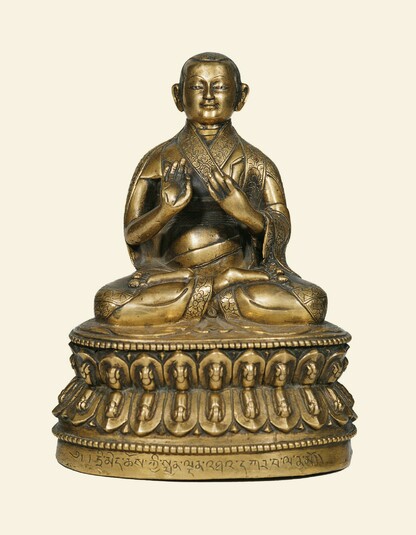
Item: Teacher (Lama)
| Origin Location | Tibet |
|---|---|
| Date Range | 1400 - 1499 |
| Lineages | Bon and Buddhist |
| Size | 16.60cm (6.54in) high |
| Material | Metal, Copper Inlay, Silver Inlay |
| Collection | Private |
Classification: Person
Drime Chokyi Chenden Takarwa. Aside from the inscription this teacher is unidentified. Is the name that is inscribed on the bottom front of the sculpture an epithet? Is his name included in the epithet? Does Takarwa refer or relate in some way to Shenchen Lugu and the place of Takarwa found in the Shenchen biography? Or, is Takarwa a reference to a location in Dolpo, Nepal. Is this teacher Buddhist or Bon? (See Bon Shirts that wrap to the left).
Note that the shirt wraps to the left side and not towards the right. In Buddhism the shirt would typically wrap towards the proper right side with the opening easily accessible to the right hand. In paintings and sculpture the Buddhist artists don't always adhere to fixed rules and may have the shirts folding either to the right or the left depending on the over-all composition of a subject and how the eye will read the line work.
With Buddhist sculpture the shirt typically folds to the right. However, with sets of paintings depicting lineage teachers it is very different and it can go either way. A very good example of this alternating folds is found with the Karma Kamtsang Mahamudra Lineage painting set from Rumtek Monastery. This set of paintings depicts a central Vajradhara in a single composition and each following lineage teacher, also in a single composition, is staggered to the right or the left of the central axis of the rectangular painting. In the early compositions of the set all of the paintings that have the teacher on the left has the shirt folded to the left. All of the early teachers on the right with shirts have them folded to the right. The later teachers in the same series begin to be less rigid and some are folded left and some folded right regardless of their position to the right or left of the central axis. This establishes that there is a flexibility with artists painting Buddhist subjects.
The Bon religion typically folds the shirt to the left side in the majority of both paintings and sculpture found on the HAR website.
Jeff Watt 2-2012
Tibetan Printed Script (Uchen)
Wylie Transliteration: dri med chos kyi spyan ldan 'tha' dkar ba la na mo.
Sculpture: Tsang Province Atelier (Teachers)
Sculpture: Tsang Atelier (Inscriptions)
Tibet: Tsuglakang Temple, Lhasa (Visual Dharma)
Bon Sculpture Masterworks
Subject: Bon Shirts (Left Folding)
Sculpture: Tsang Province Atelier, Tibet
Tibet: Tsuglakang Temple (Teachers)
Sculpture: Tsang Province Atelier (Bon Religion)
Bon: Teachers (Early Sculpture)
